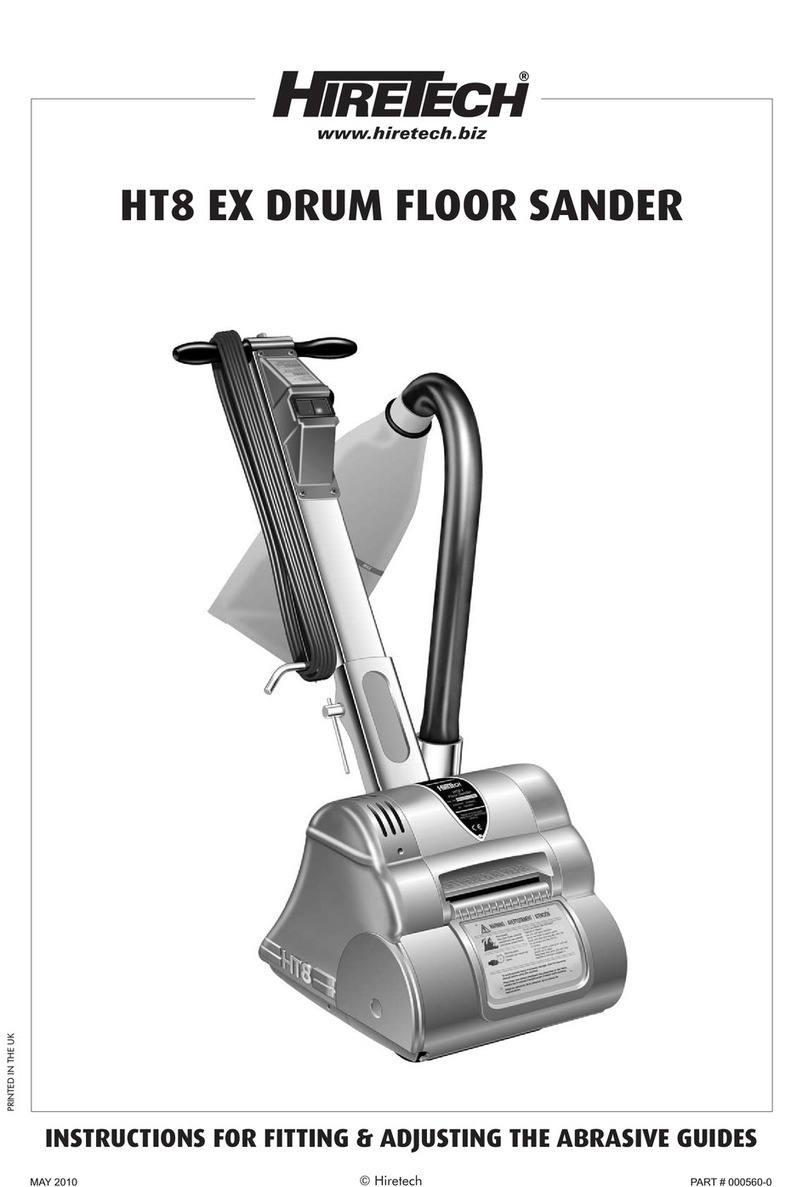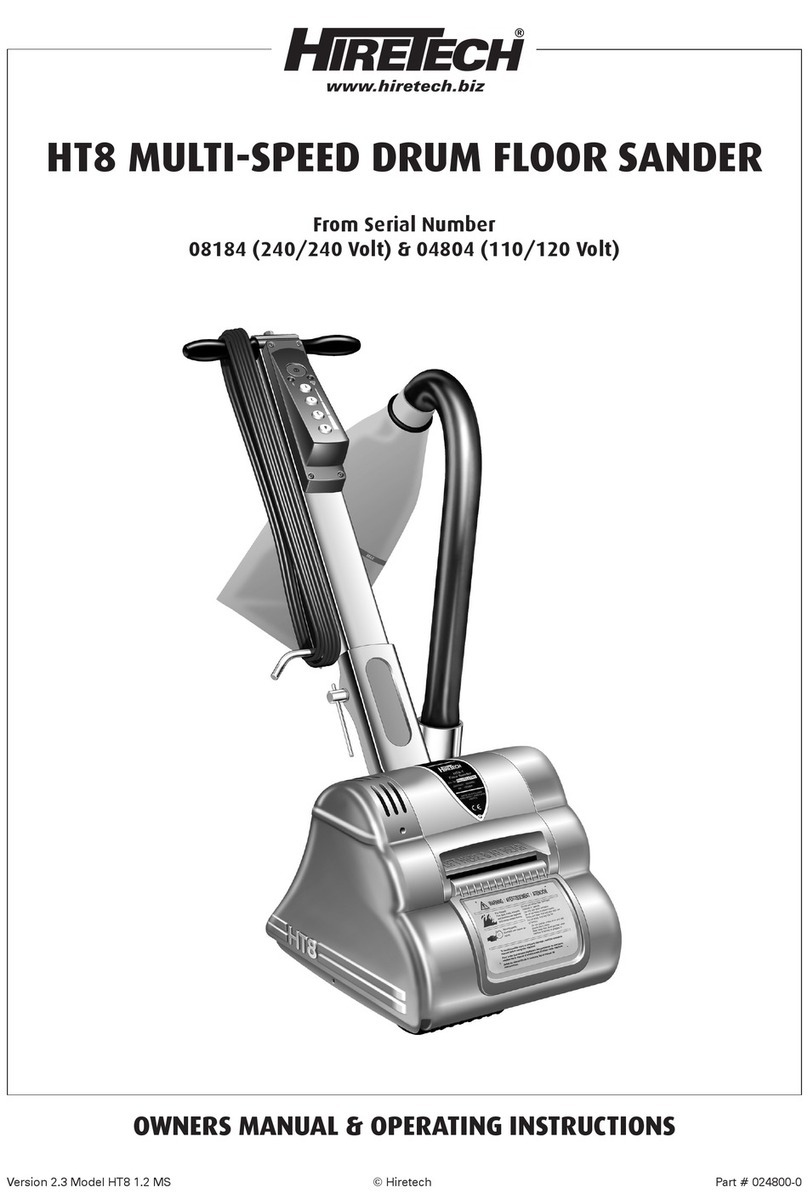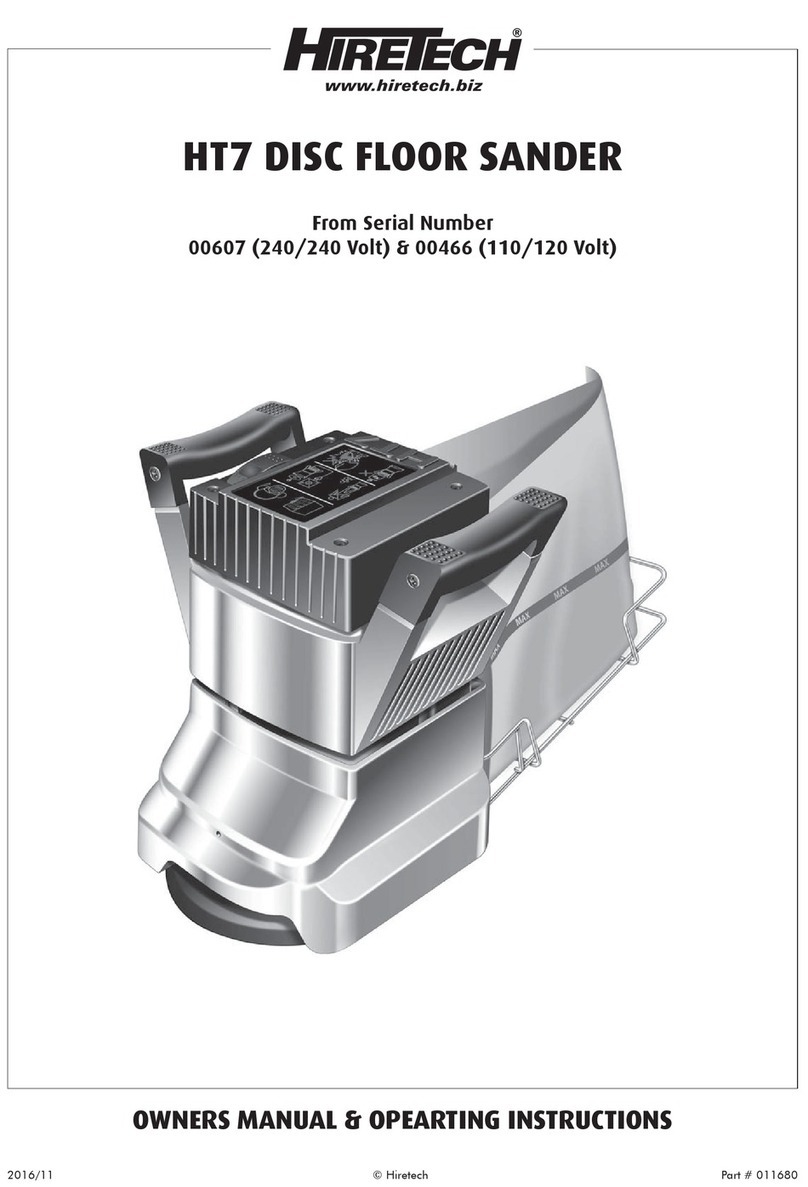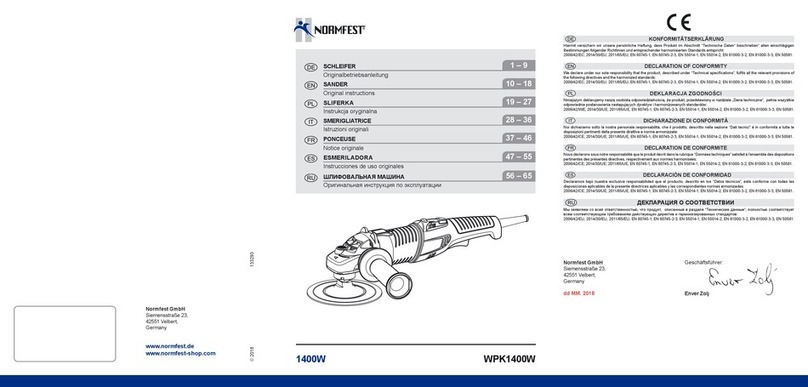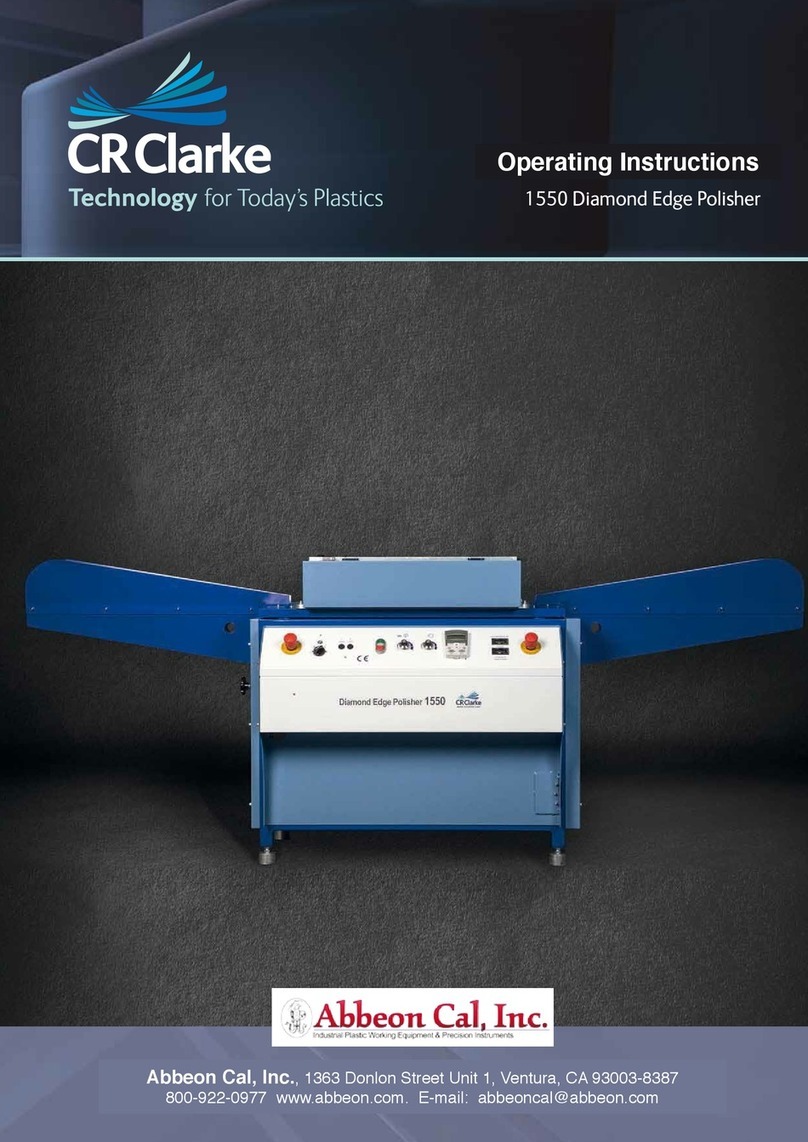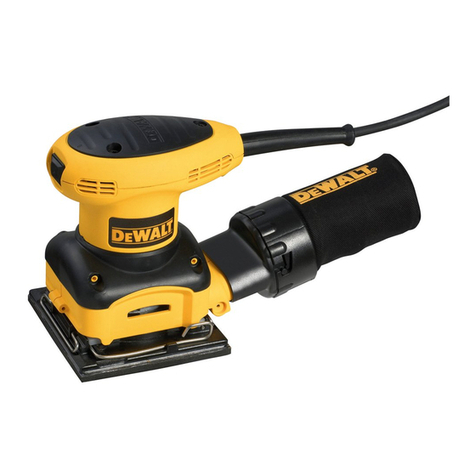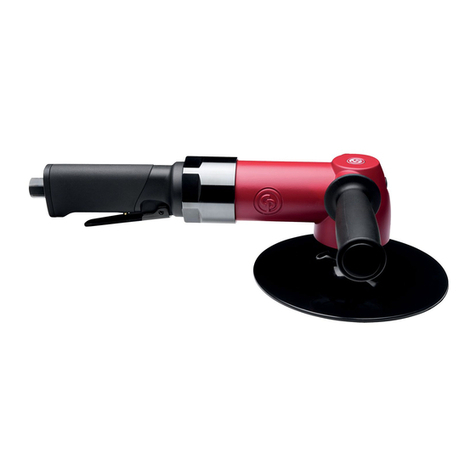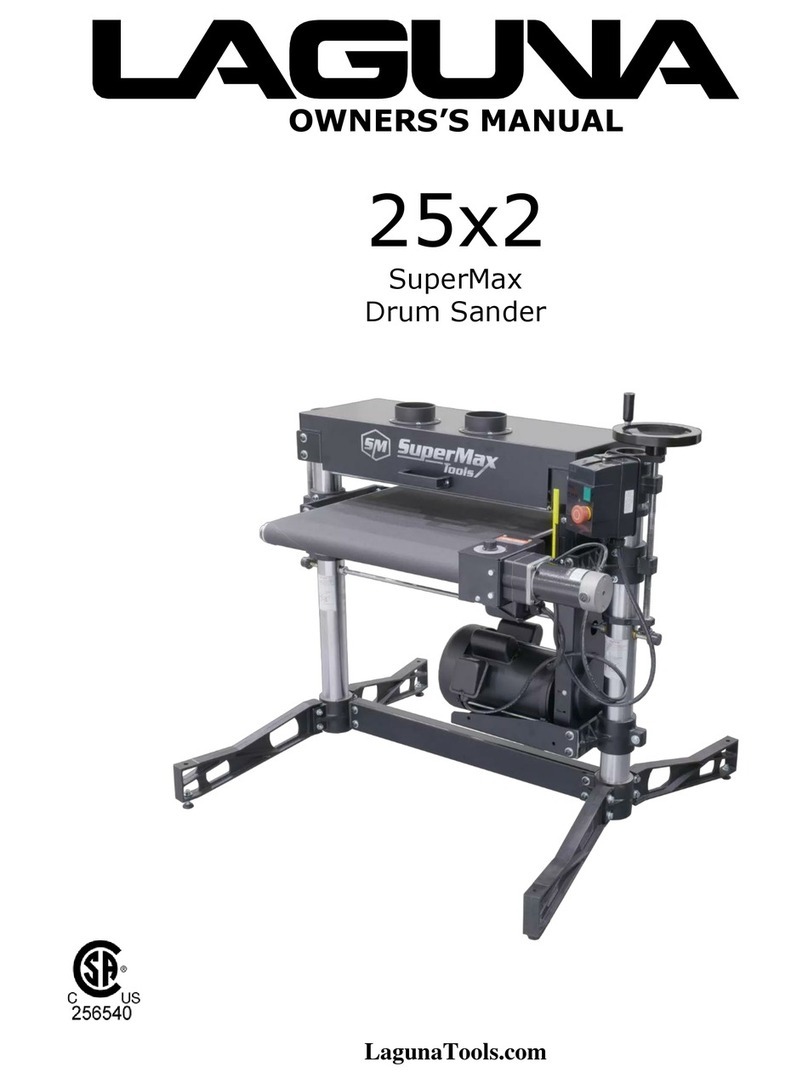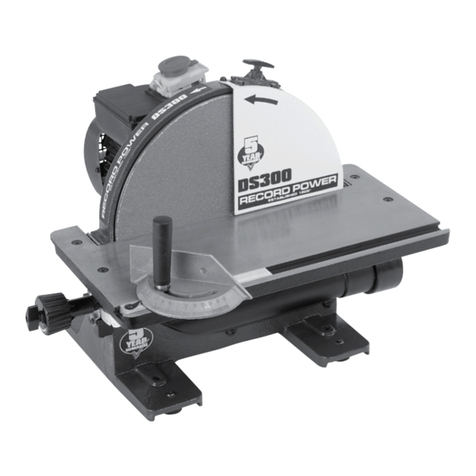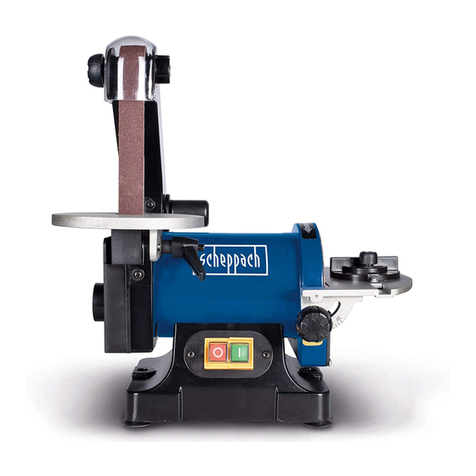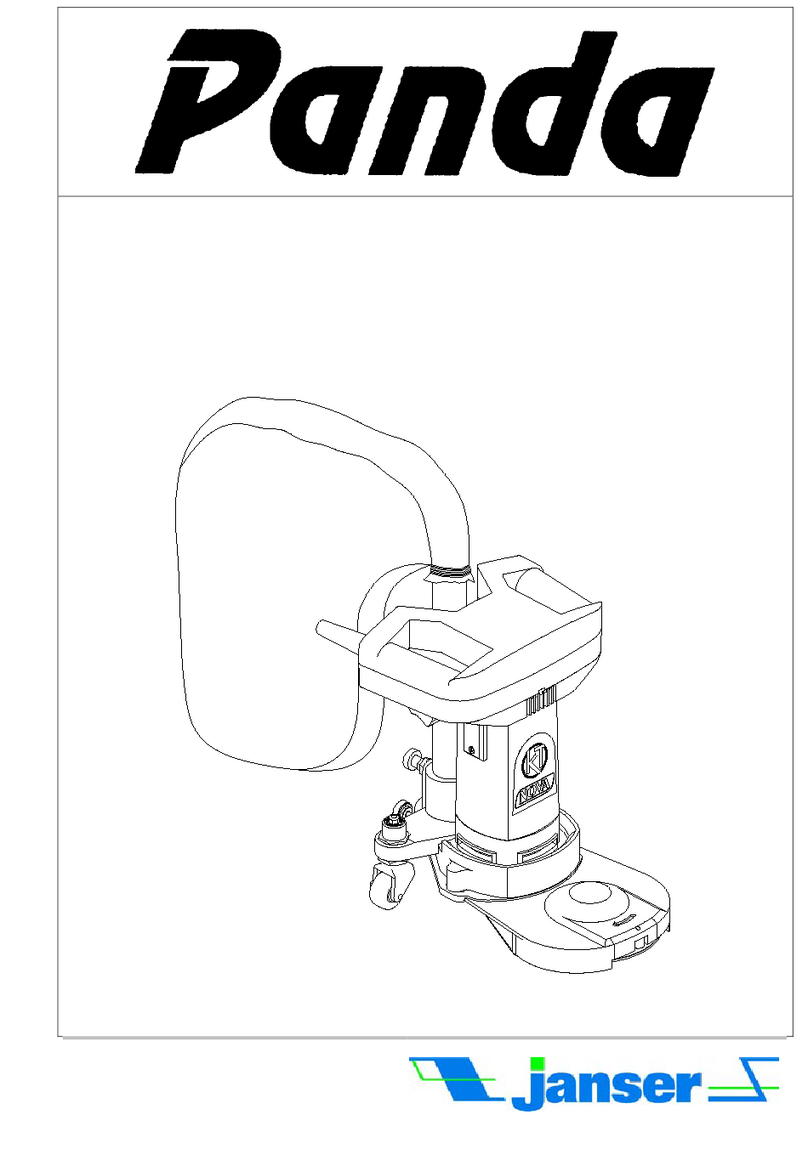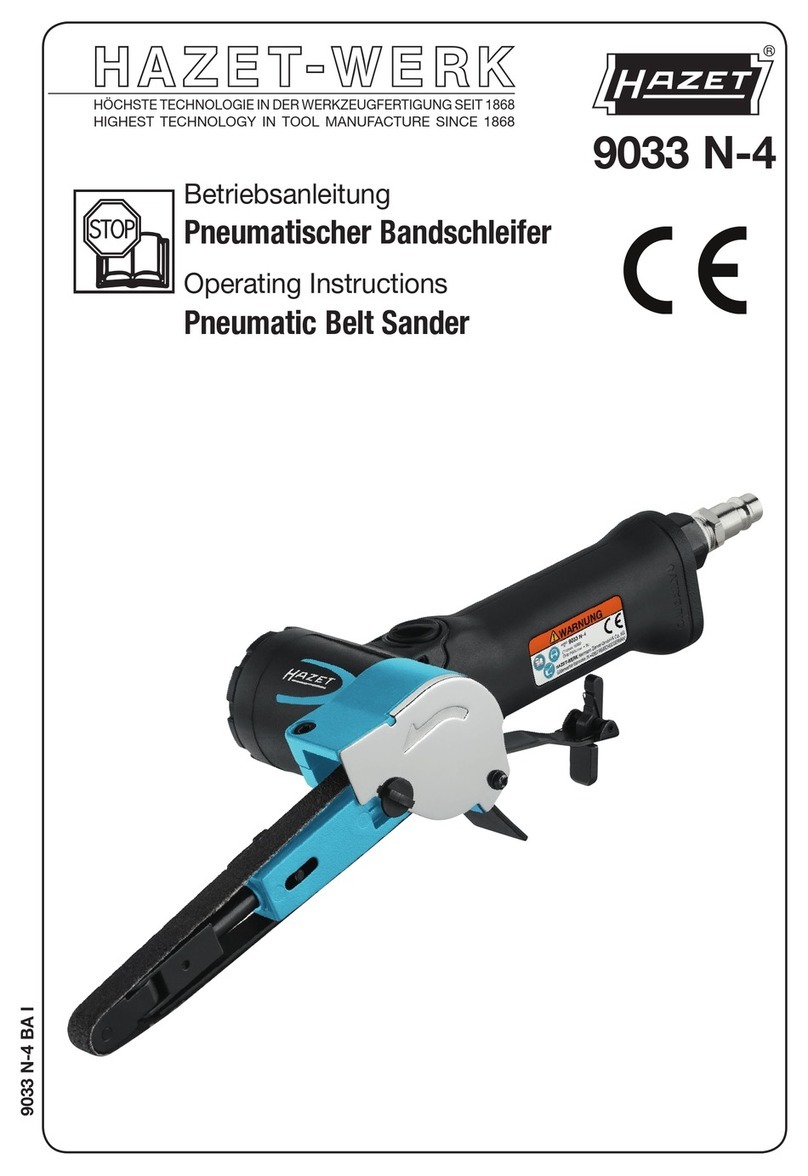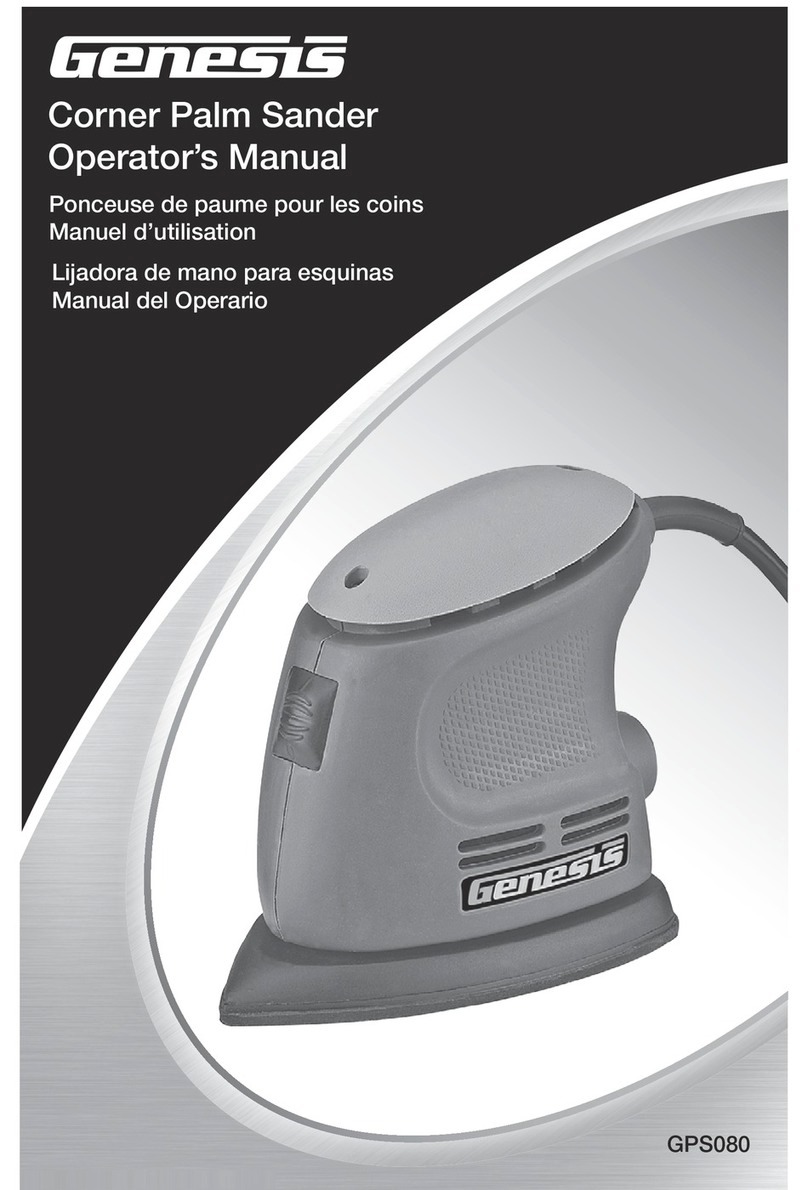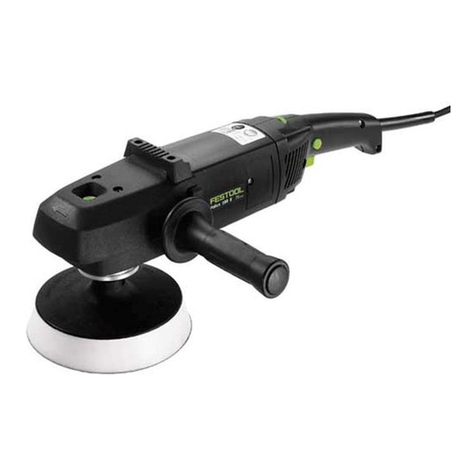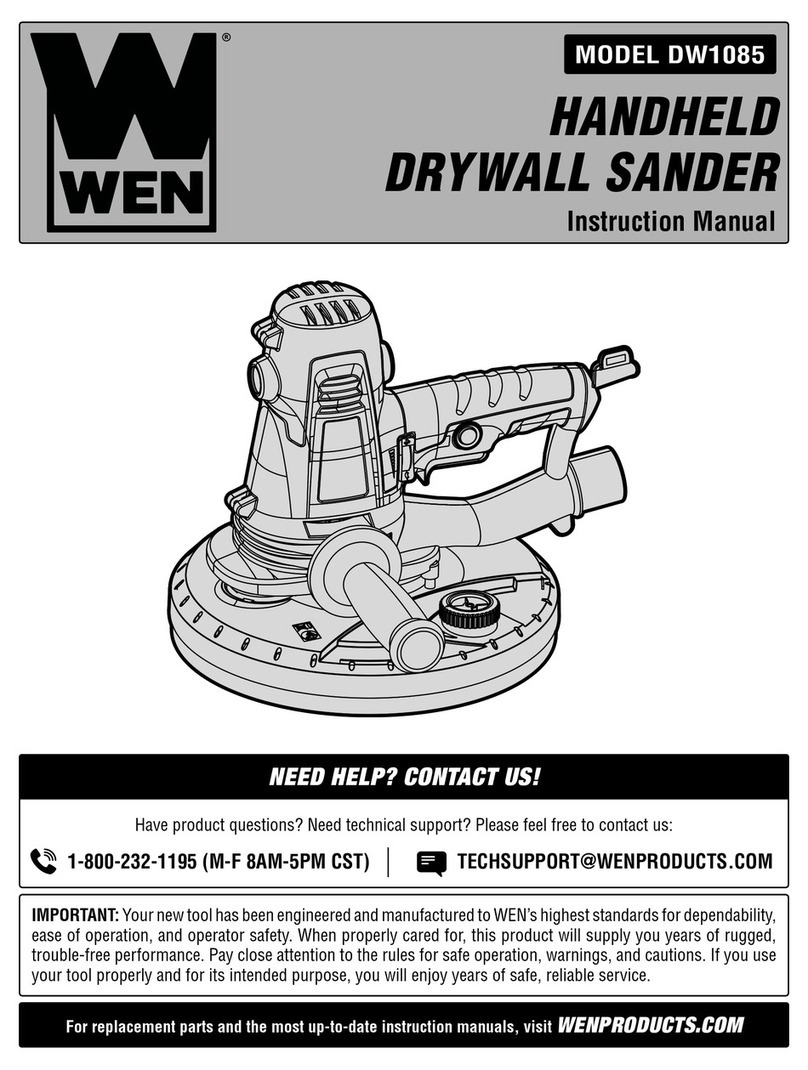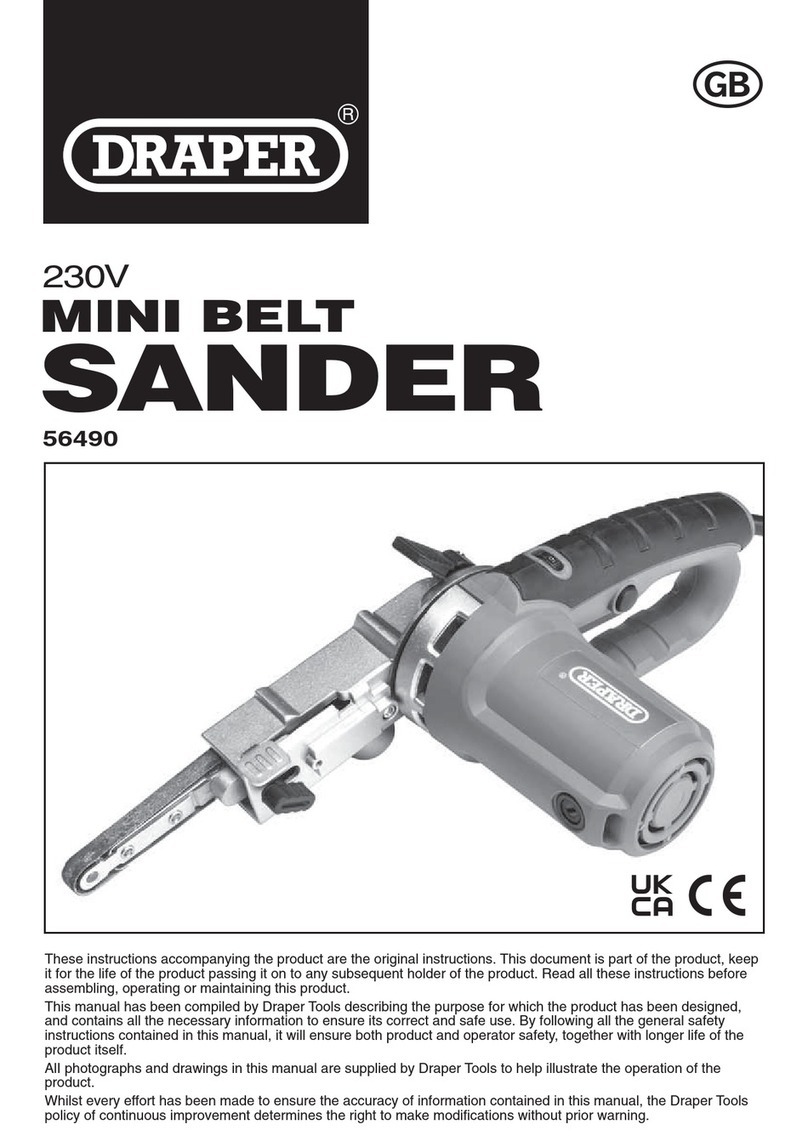HireTech HT7-2 System manual

DISC FLOOR SANDER MODEL HT7-2
OWNERS MANUAL OPERATING INSTRUCTIONS&
0703/1811 REF PART. 69 # 011680
PRINTED IN THE UK
© Hiretech
ABC
From Serial Number
00607 (220/240 Volt) & 00466 (110/120 Volt)

NORTH AMERICAN SAFETY INSTRUCTIONS
WARNING: This floor sanding machine must be grounded.
This floor-sanding machine shall be grounded while in use to protect the operator from electric
shock. The machine is provided with a three-conductor cord and a moulded three-contact
grounding type attachment plug to fit the proper grounding type receptacle. The Green (or
Green and Yellow) conductor in the cord is the grounding wire. Never connect this wire to other
than the grounding pin of the attachment plug.
This floor-sanding machine is provided with an attachment plug as shown in sketch A. It is
intended for use on a nominal 120 volt circuit. If a properly grounded receptacle as shown in
sketch A is not available, an adaptor as shown in sketch 'C' should be installed as shown in sketch
B if the outlet box that houses the receptacle is grounded. Be sure to fasten the grounding tab with
a metal faceplate screw.
WARNING: Risk of explosion.
Floor sanding can result in an explosive mixture of fine dust and air. Use floor-sanding machine
only in a well-ventilated area free from any flame or match.
WARNING: Of potential injury.
Moving Parts - to reduce the risk of injury, unplug the machine before replacing abrasive sheets
or carrying out any form of adjustment or servicing.
USE AND APPLICATION
This machine is intended for commercial use connected with the laying and maintaining of wooden floors and
decks.
These types of surfaces may be found both in commercial and household environments.
ATTACHMENT PLUG SKETCH ‘C’
METAL
SCREW
COVER OF GROUNDED
‘B’OUTLET BOX SKETCH
ADAPTER
GROUNDING
MEANS
COVER OF GROUNDED
‘A’OUTLET BOX SKETCH
GROUNDING PIN

CONTENTS
WARNING i
MAINS CABLE WIRING PLUG- i
SPARE PARTS I
SPECIFICATION 1
SAFETY 1
SET UP
Assembly and Transport 2
Installing Abrasive Disc 2
PREPARATION 2
OPERATION 2,3
FLOOR SANDING TECHNIQUE
Drum Floor Sander 4
Disc Floor Sander 4
Orbital Floor Sander 4
Hand Sanding 4
FLOOR TYPES
Sanding Plank & Strip Floors 4
Veneered, Laminated & Thinner Floors 4
Parquet & Block Floors 5
Between Coats of Finish (Varnish) 5
ABRASIVE PAPER GUIDE 6
SERVICE AND ROUTINE MAINTENANCE
General 7
Visual Inspection 7
Dust Control System 7
Drive 7
Lubrication 7
Care of Motor 7,8
Sanding Pad Removal & Replacement 8
Sanding Pad Trimming 9
Adjsuting the Castors 10
Electrical Testing 10
FAULT FINDING 11
HT PARTS DRAWING7-2 12
HT PARTS LIST7-2 13
HT CIRCUIT DIAGRAM7-2 14
DECLARATION OF CONFORMITY 15
SERVICE REPAIR& 16
WARNING
For safe operation of this machine, read and understand all instructions. Look for the ‘warning/caution’ symbol.
This symbol means that if you do not follow the instructions injury can occur to the operator and
damage to the machine and floor may result.
MAINS CABLE WIRING PLUG-
Hiretech reserves the right to make changes or improvements to it's products without prior notice.
®
i
NORTH AMERICA
BLACK
WHITE
GREEN
BRASS
TERMINAL
SILVER
TERMINAL
EU
BLUE BROWN
GREEN/
YELLOW
UNITED KINGDOM
BLUE
(N - )NEUTRAL BROWN
(L - )LINE
GREEN YELLOW/
(E - )EARTH
SPARE PARTS
Use Hiretech genuine spare parts only for service and repair. Use of non-approved parts will void the product
warranty. See the back cover of this manual for the terms and conditions of the Hiretech Limited Warranty.

SPECIFICATION
The 7-2 Hiretech Edger (Disc Floor Sander) willHT
sand hard and soft wood floors, cork and
composition floors and any solid wood surface that
requires rapid sanding and leveling to a fine finish.
Ideal for confined areas such as closets and stair
treads the 7-2 will sand right up to the edge of aHT
floor without damage to the base (skirting) board.
Completely self contained with a high efficiency dust
pick-up the 7-2 is a high performance sanderHT
suitable for professional and home owner use.
SAFETY
1. For safety it is recommended that a residual
current circuit breaker (ground fault interrupter)
is used with this machine.
2. Check the operating voltage is correct and that
the machine is switched (O) beforeOFF
connecting to the power supply.
3. Never attempt to lock the switch in the (I)ON
position with tape or by any other means.
4. Always disconnect from the power supply when
changing the abrasive disc, servicing the floor
sander, replacing the dust bag or leaving the
machine unattended.
5. Always replace the dust bag (paper type) or
empty the dust bag (cloth type) when the dust in
the bag reaches the ‘ ’ line or when theMAX
machine is left unattended.
6. Never dispose of or empty the contents of the
dust bag into a fire or incinerator.
7. Never reuse the paper dust bag or use a non
standard bag. Cloth type bags must be in good
condition with no holes.
8. Always wear a dust mask when using the floor
sander, handling the dust bag or cleaning the
machine after use.
9. Wear ear protection when using the floor sander.
10. Ensure adequate ventilation of the work area to
avoid the formation of a combustible mixture of
flying dust and air.
11. Never smoke when using or servicing the floor
sander or when handling the dust bag.
12. Never expose the machine to rain or damp.
Always store in a dry place.
13. Stop the floor sander immediately if damage to
the machine or abrasive disc is suspected.
14. Never allow the power cable to come into contact
with the sanding disc when the floor sander is in
operation. If the power cable becomes damaged
and the inner conductors are exposed switch the
power and remove the plug beforeOFF
attempting to move the machine. The cable must
be replaced by an authorised agent or qualified
electrician using genuine Hiretech spare parts
only.
15. Keep hands, feet and loose clothing away from
all moving parts of the machine.
16. Punch down or remove all nails, screws, tacks
and other fixings from the floor before sanding to
prevent contact with the sanding disc.
17. Never use the machine above waist height as
control will be lost.
18. Keep children and pets clear at all times.
19. If the machine should fail to operate refer to the
fault finding guide on page 8.
1
CAUTION - read the following Safety
and Operational notes before using your
HT7-2 Disc Floor Sander.
Noise: 100 dBa at 1metre (3’ 3")
Switch: Bias Off, double pole.
Motor RPM: 13,000
Disc RPM: 3,000
Moving Parts: Sealed for life ball bearings.
Weight: 16.4kg (36.2lbs)
0.04 M² H Aeq8
(8 Hr. RMS )
7" (178") dia. x 7/8“ (22mm) dia.
centre hole. 24 to 120 grit fibre or
paper back.
Abrasive:
Continuous heavy duty AC/DC self
cooling 4 brush.
7" (178mm) dia. Metal backed and
rubber bonded.
High impact ABS with bronze bush.
Hardened steel alloy pinion and
large diameter aluminium bronze
drive gear.
Seated oversize vacuum fan,
disposable paper dust or cloth
bag.bags
Disc Guard:
Drive:
110/120 V 50/60 Hz
220/240 V 50/60 Hz
110/120 V 8A
220/250 V 5A
Average
Load Current:
110/120 V 15A
220/250 V 8A
Dust Pickup:
Vibration:
Power Supply:
Off Load
Current:
Motor:
Sanding Pad:

SET UP
Assembly and Transport
1. Always carry the floor sander by the two handles
with the bag frame in the up position and the
power cable stowed around the bag frame.
Protect the sanding disc with an abrasive disc
and ensure that the clamp bolt is secure. Ensure
that the floor sander is secure and cannot move
when being transported in a vehicle. The floor
sander is heavy. Take care when lifting and
carrying the machine.
2. To prepare the floor sander for use place the
machine on the floor and remove the cable from
the bag frame. Check that the cable is in good
condition and that all fittings are secure.
3. Lower the dust bag support frame and fit a paper
dust bag following the instructions printed on the
bag. Do not reuse or use a non standard bag. If a
cloth type bag is used ensure that it is tied securely
around the dust outlet and that the bag is in good
condition with no holes.
4. To dismantle the floor sander reverse procedure
2 to 3 above.
Installing Abrasive Disc
1. Ensure the power cable is disconnected from the
power supply.
2. Tip the floor sander upside down and rest the
machine on it's top and handles.
3. Remove the Wrench Ref.61 from the clips inside
the skirt of the floor sander situated in between
the castors and remove the Bolt Clamp Ref.59
and Washer Clamp Ref.58 from the centre of the
sanding disc.
4. Select a suitable grade of abrasive disc (see
Abrasive Paper Guide on page 5).
5. Place the bolt clamp through the centre of the
washer clamp and abrasive disc and carefully
thread the bolt into the sanding disc.
CAUTION - never fit more than one
abrasive disc . If more than one abrasive
disc is fitted the setup of the sander will
be affected and the clamp bolt and
washer and sanding pad will be
damaged.
6. Using the wrench, tighten the bolt clamp
ensuring that the abrasive disc is centred and the
washer clamp is properly located. The bolt
should be secure but do not try to over tighten.
Heavy grit abrasive discs will seat down as you
tighten the bolt so take care to ensure the washer
clamp is properly located. Heavy grit abrasive
discs may not lie flat on the sanding disc, this is
quite normal and the abrasive disc will flatten
immediately upon operation.
7. Do not use damaged or incorrectly sized
abrasive discs under any circumstance, damage
will result to the machine and floor.
PREPARATION
1. Where possible remove all furniture from the
area or room. The 7-2 Disc Floor SanderHT
features an efficient dust pickup, however, some
dust will escape. Protect all vulnerable
furnishings with dust sheets.
2. Remove all tacks, staples and other unwanted
fixings from the floor. Failure to do so will result
in damage to the abrasive disc and sanding disc.
3. Punch all nails below the surface of the floor
using a suitable nail punch and hammer. Any
screws used to fix boards should be counter sunk
below the surface. During sanding, any nails or
screws that become exposed must be punched or
counter sunk further.
4. Firmly fix all loose boards or blocks.
5. Remove heavy wax, grease and dirt deposits by
hand.
6. Sweep and vacuum the floor thoroughly to
remove dirt and discarded fixings.
7. Ensure good ventilation by opening windows.
8. If sanding a work bench or similar work piece
follow the instructions above to prepare it ready
for sanding. Make sure that the work piece is
secure. Never use the floor sander above waist
height.
Note: Use Hiretechgenuine floor sander abrasives for
the best sanding performance and finish.
OPERATION
1. Move the floor sander to the location of your
work.
2. Make sure the switch is in the (O) positionOFF
then connect the power cable to a suitable power
supply ideally located behind or to one side of
the machine and work area.
3. Wear a dust mask and ear defenders.
4. Kneel behind the machine on one knee (use knee
pads to protect knees) and hold both handles
with the power cable held in the right hand in a
small loop and then pass the cable over the right
shoulder. Tilt the floor sander back so that the
2

sanding disc does not touch the floor or work
piece.
5. Switch by pushing the / switch to (I)ON ON OFF
position and hold in place with your thumb. To
switch (O), release the pressure on theOFF
switch and it will automatically return to the OFF
position.
CAUTION HT- the 7-2 Disc Floor Sander
is a powerful machine. Always ensure
you have a firm grip before switching on.
6. Now lower the floor sander slowly forward so
that the abrasive disc comes into contact with the
floor or work piece. At the same time move the
machine in a sideways motion so when the
abrasive disc comes into contact with the work
surface it is moving to one side. This will ensure
that the sander does not dwell in one position
and damage the floor or work piece.
CAUTION - to prevent damage to the
floor surface, work piece or machine
follow these rules.
i. Always ensure that the floor sander is
moving when in operation and the
sanding disc is in contact with the floor.
ii. Never lift the back of the machine when
sanding.
iii. Never apply pressure to try to increase the
rate of sanding. Damage to the floor or
work piece will occur.
iv. Never bounce or drop the floor sander on
to the floor or work piece, always lower the
machine gently.
v. Never dwell in one place, move steadily at
all times.
vi. Never allow the power cable to come into
contact with the sanding disc.
7. When the dust in the dust bag reaches the ‘ ’MAX
line stop sanding. Switch (O) andOFF
disconnect the power cable from the power
supply and remove the paper dust bag. Turn the
top of the paper dust bag over to stop the escape
of dust and dispose of into a suitable container.
Never reuse the paper dust bag or empty it.
Never dispose of it into a fire. If the cloth bag is
used empty into a suitable container being
careful to contain the dust. Do not dispose of the
contents into a fire.
8. Fit a new paper dust bag, or refit the cloth bag.
Reconnect the floor sander to the power supply
and continue sanding.
3
9. When taking a break from work switch ‘O’OFF
and disconnect the power cable from the supply,
remove and dispose of the paper dust bag, or
empty the cloth bag as detailed in 7. above.
Never leave the floor sander unattended with a
dust bag in place containing dust.
10. On completion disconnect the power cable from
the supply. Remove and dispose of the paper
dust bag, or empty the cloth bag as detailed in 7.
above. Replace the bag frame in its up position
and stow the power cable. Leave the old abrasive
disc inplace to protect the sanding disc. Carry out
maintenance as recommended in Maintenance
and Servicing.
- never leave the floor sanderDANGER
unattended with dust in the dust bag.
Always remove the dust bag and dispose
of into a suitable container.

FLOOR SANDING TECHNIQUE
HT8-1.2 Floor Sander (Drum) - a powerful floor
sander designed for the rapid leveling and sanding of
all types of wood flooring excluding thin laminated or
veneered floors. Load the sander with abrasive
making sure that it is skin tight around the drum.
Loose sheets will tear. Place the sander on the right
hand wall (unless you are making an angled cut on
uneven floors) with about two thirds of the floor in
front of you. Start the sander with the drum off the
floor then walk forward at an even pace and ease the
drum on to the floor. As you near the end of the pass,
gradually raise the drum off the floor. Practice this
technique before turning on the sander.
Cover the same path you made on the forward cut by
pulling the machine backwards and easing the drum
to the floor as you begin the backward pass until you
reach the original starting point, then ease the drum
off the floor.
When two thirds of the floor is sanded, turn the floor
sander around and sand the remaining third in the
same way. Overlap the one third area by 0.6 to 0.9
meters (2 to 3 feet ) with the two thirds area to blend
the two areas together.
WARNING - never bounce the sanding
drum or dwell in one place as this will
sand dips and hollows in the floor.
HT7-2 Disc Floor Sander (Edger) - a powerful disc
floor sander designed for sanding along the edges of
a floor without damaging the baseboards or
moldings. Also suitable for smaller areas where the
HT8-1.2 Floor Sander will not reach like stair treads
and closets load the abrasive disc making sure the
retaining bolt is tight. Start the edger with the disc off
the floor then lower the disc to the floor as you move
the sander. Work progressively moving the sander in
a sweeping motion from side to side.
HTF-2 Floor Sander (Orbital) - a orbital action floor
sander designed for re-finishing, sanding between
coats of varnish and re-surfacing floors in good
condition. load the abrasive sheet, pad or strip. Start
the sander, move immediately and sand in the
direction of the grain using the same technique as the
drum floor sander. For difficult to reach areas use the
disc floor sander with a fine grit abrasive, or sand by
hand.
Hand Sanding - to sand difficult to reach areas
scrape and sand the floor by hand. Use a scraper to
remove old finishes, always scraping in the direction
of the grain, and then sand by hand using the same
grit abrasive as you finished with when machine
sanding. See Floor Sanding Technique diagrams on
page 5.
FLOOR TYPES
PLANK STRIP FLOORS&
Old floors in good condition - when the floor is in
good condition - no uneven edges, cupping or
crowning of planks and strips - and you want to re-
surface the floor, sanding back to new wood, start
sanding in the direction of the planks or strips - with
the wood grain. Start with a medium grit abrasive.
Complete the first cut with the 8-1.2 Floor SanderHT
then sand up to the baseboards and door thresholds
with the 7-2 Disc Floor Sander, using a mediumHT
grit abrasive, blending the edges in with the main
floor area. Sweep the floor. Using a medium/fine grit
abrasive, sand the main floor area with the drum
sander and then complete the floor with the edger
using a fine grit abrasive. Sweep the floor. Finish
sanding the main floor area with the drum floor
sander using a fine grit abrasive. If the floor is in
particularly good condition (level with no deep
scratches or blemishes) you may re-surface the floor
using the -2 Floor Sander, however, as theHTF
sanding action of this machine is less aggressive than
the 81.2 Floor Sander the job will take more time.HT
Uneven floors - when the floor is uneven sand
diagonally at 45 across the room in both directions
o
using the 8-1.2 Floor Sander with a coarse gritHT
abrasive. Only make one cut on both diagonals, this
will achieve a basic level. Now complete the floor as
for a level strip or plank floor. Use the same grit
abrasive as was used on the 45 cut for the first cut
o
parallel to the planks or strips.
Floors with an existing finish - when re-finishing a
floor remove as little of the existing surface as
possible. If the old finish is worn and the floor is
generally in good condition use the -2 FloorHTF
Sander with abrasive pads and strips whichHiretech
have been especially designed for re-finishing floors.
These will maintain the integrity of any stain used to
colour the wood and prepare the surface for a new
coat of finish. If the floor is badly marked and
scratched and has to be sanded back to new wood
use the 8-1.2 Floor Sander and 7-2 Disc FloorHT HT
Sander. Always try a medium grit paper first,
particularly on a diagonal cut. If 90% of the old finish
is removed and the floor is generally leveled, you do
not need to use a coarse grit abrasive.
VENEERED LAMINATED THINNER FLOORS,&
Use the -2 Floor Sander for veneered andHTF
laminated floors or thinner floors that may have been
subjected to repeated sanding. The -2 willHTF
remove old surface finishes and prepare the floor for
re-finishing. Sand the floor using the same method
as a strip, plank, or parquet floor. If the floor has
deeper scratches or marks these should be sanded
4

out by hand and blended in with the main floor. To
check the wood depth in the floor remove a
baseboard or molding from around the edge of the
floor. This should provide access to the edge of the
floor for inspection.
PARQUET BLOCK FLOORS&
The grain of the wood will run in a number of
directions so sand the floor in the direction of the
main source of natural light in the room. If there is no
source of natural light sand in the direction of the
longest side of the room or, if the room is square, in
the direction the furniture is laid out and how people
normally use and view the room.
This technique will help mask any imperfections in the
floor. Complete the sanding operation as detailed
for plank or strip floors.
BETWEEN COATS OF FINISH VARNISH()
Use the -2 Floor Sander to sand between coats ofHTF
floor finish, particularly when using water based
varnishes. These types of finishes tend to raise the
wood grain when first applied to raw wood. Allow
each coat of varnish to dry completely following the
manufactures directions. Use Hiretech abrasive pads
to sand between each coat of varnish. The fine
abrasive pads will remove light brush/applicator
marks and raised grain while maintaining the
integrity of the coat of varnish applied.
unsanded boards sanded boards
level very uneven
floors by sanding
diagonally in both
directions
unsanded boards
unsanded boards
Level uneven floors.
Sand main floor area.
Sand and blend edges in with main floor area.
FLOOR SANDING TECHNIQUE
Plank and Strip Floors - sand in the
direction the boards are laid, with the
wood grain.
-Parquet and Wood Block Floors
sand in the direction of the main
source of natural light. If there is no
natural source of light, sand in the
direction of the longest side of the
room. If the room is square, sand in
the direction the furniture is laid out
and how people normally use the
room.
5

FLOOR SANDER ABRASIVE GUIDE
6
DO NOT OVER SAND USE ONLY AS HEAVY GRADE ABRASIVE AS IT TAKES TO DO THE-
JOB PROGRESS FROM FIRST GRADE USED THROUGH FOLLOWING GRADES TO.
REMOVE ALL VISIBLE SANDING MARKS DO NOT MISS GRADE.A.
FLOOR SANDER ABRASIVES
Abrasive Grade Floor Type and Condition
Grit P24 Open Coat
(Very Coarse non-glogging)
For removing surface coatings from old floors such as varnish, stains and wax
polishes. For the rapid sanding and removal of scratches and marks. Sanding
level the joints of sub-flooring like particle board and masonite.
Grit P24
(Very Coarse)
For the rapid sanding and removal of scratches and marks. Sanding level the
joints of sub-flooring like particle board and masonite.
Grit P36 to P50
(Coarse/Medium)
For removing surface coatings from old floors such as varnish, stains and wax
polishes. For the rapid sanding and removal of scratches and light marks.
Sanding level the joints of sub-flooring like particle board and masonite.
Grit P60 to P80
(Medium)
For the rapid sanding and removal of scratches and light marks. Sanding level
the joints of sub-flooring like particle board and masonite.
Grit P100 to P120
(Medium/Fine)
Intermediate sanding of all types of wood floor. For final sanding of all types of
wood floor.
Grit P150 - P180
(Fine/Very Fine)
For final sanding of all types of wood floor. First sanding of cork or composition
floors. For sanding between coats of solvent based and 2 pack varnishes.
Hiretech Abrasives
Hiretech recommend the
following abrasive range
which are suitable for all floor
types and applications.
P16 - - 01025 - - -
P24 Grit Open Coat 01001 - - 01044 - -
P24 Grit 01002 01010 01026 - - -
P36 Grit - 01011 ----
P40 Grit 01003 01012 - 01045 01750 -
P50 Grit - 01013 01027 - - -
P60 Grit - 01014 - - 01751 -
P80 Grit 01004 01015 01028 01046 01752 -
P100 Grit - 01016 ----
P120 Grit 01005 01017 01030 01048 01754 -
P150 Grit - 01018 ----
P180Grit ----01756 -
P280Grit/BackingPad -----01769
HTF FLOOR
SANDER SHEET
ADHESIVE
BACKED
25 & 50/CASE
HTF ABASRIVE
PAD
20/CASE
HT8/DU8
FLOOR SANDER
SHEET
20 & 50/CASE
HT8 EX
FLOOR SANDER
BELTS
5/CASE
HT7/SUPER 7
EDGER DISC
FIBRE BACKED
25/CASE
HT7/SUPER 7
EDGER DISC
PAPER BACKED
25 & 50/CASE

SERVICE ROUTINE MAINTENANCE&
CAUTION - maintenance and repairs
must be carried out by authorised
personnel only. To prevent injury, always
remove the power cable from the power
supply before undertaking any work on
the machine. Do not operate this
machine unless it is fully assembled and
all guards are in place. Use Hiretech
genuine spare parts only.
General
1. Always make a list when first examining the
machine, to remind you of parts or action
needed on completion of repair/service.
2. The 7-2 is subject to high speeds. All screwsHT
should be fitted using a suitable thread lock
compound.
3. On completion of any work or service on an
electrical tool or appliance statutory safety tests
must be carried out by a competent person and
recorded (see Testing for Electrical Safety page 7
and 8).
4. The 7-2 needs no lubrication during routineHT
servicing.
5. Always ensure that the electrical supply is
disconnected before starting any routine
servicing or repair.
Visual Inspection
1. To clean the machine and remove dust, use a
vacuum cleaner to avoid damage and prevent
inhalation of dust.
2. Examine all guards and mechanical parts for
condition including the Disc Guard Ref.54 which
should be undamaged and moving freely.
3. Examine the sanding pad, a worn or damaged
pad must be replaced to maintain performance
and to avoid injury. There must be a minimum of
4mm ( / “) ‘tread depth’.
5
32
4. Examine the power cable for damage. If the
outer insulation shows the slightest of abrasions
or the inner conductors are exposed then the
cable must be replaced. The cable must not be
repaired with tape or insulation sleeve.
5. Ensure all labels are sound, readable and
secure.
6. Check that the castors are sound and moving
freely. If a castor is found to be loose or damaged
then the ‘cutting’ angle must be checked and
reset as necessary (see Setting Castors page 9).
Replace damaged castors.
7. Check the condition of the Bolt-Clamp Ref.59
and clean the threads.
8. Check that the Wrench Ref.61 is in place and in
good condition.
9. If a cloth type bag is in service check the
condition, clogged dust bags or bags with holes
make for inefficient dust pickup.
Dust Control
1. Turn the sander upside down and rest the
machine on the handles. Check the dust skirt for
pieces of abrasive disc and build up of dust.
Clean as needed.
Drive
1. The dive gear does not require maintenance
under normal operating conditions.
Lubrication
1. The 7-2 features sealed for life bearings whichHT
do not require any lubrication. In the unlikely
event that a bearing has to be replaced use a
Hiretech genuine spare part only as the grease
contained in the bearings is special. A standard
bearing is not suitable and may result in further
damage.
2. Should the gearbox require service the gear
housing and gears must be cleaned thoroughly
and the gearbox refilled with grease Part No.
011270. This is a special grease designed for
the high speed and temperatures generated
within the gear box. Under no circumastnce
must a standard automotive grease be used.
Using such a grease will result in gear failure and
damage to the motor and other components.
The grease may also melt and leak from the gear
box staining the floor or work piece being
sanded.
Care of Motor
1. The motor must be kept clean and free from
grease and dust.
2. The motor brushes must be checked regularly.
As it is necessary to remove the Cover Motor
Ref.4 during routine electrical testing, it is then a
simple matter to check the condition of the motor
brushes and avoid costly breakdowns.
3. Replace motor brushes when any oneALL FOUR
brush has worn to 12mm ( / ”) or less in length.
15
32
Brushes slide freely in the brush holders.MUST
There is no need to remove or disconnect any
internal leads when changing the brushes, only
the small braided shunt (pigtail) is disconnected
to release the brush.
7

4. To replace the motor Brushes Ref.12.
i. Remove the four Screws Ref.1 from the
Cover Motor and lift the cover off.
ii. Remove the four Spring Brush Ref.17 and
set to one side. The springs are removed by
pushing the spring tag in towards the
brush and lifting out.
iii. Using a cross recess screwdriver remove
the four brush shunt (pigtail) retaining
screws and lock washers Ref.16.
iv. Remove the four brushes.
v. Thoroughly clean the brush assembly and
housing using a soft brush and a suitable
vacuum cleaner.
vi. Inspect the four brushes for damage or
wear and if any one brush is found to be
damaged or worn to a length of
/ “(16mm) or less then replace all four
5
8
brushes. Always replace all four brushes
together.
vii. When replacing brushes ensure that each
brush moves freely in each holder and fit
the brush with the shunt (pigtail) in such a
position as to allow free movement
throughout the brush life. Ensure that
each brush shunt is connected securely
with the Screw and Washer Ref.16. (two
spare screws and washers are provided
with each pack of brushes). The brush
should be fitted so that the brush shunt
(pigtail) is at the bottom of the brush.
viii. Refit the brush springs by inserting into the
holder with the coil spring over the brush
then push in until the tag comes into
contact with the holder, slide the tag away
from the brush and release. The brush
spring will clip into position. Check the
springs and brushes for correct alignment
and free movement.
ix. Carry out electrical safety test and record
results (see Testing for Electrical Safety
page 7 and 8).
x. Finally check that all leads and cables are
clear of moving parts and will not be
trapped when refitting the cover motor.
xi. Refit the cover motor and secure with the
four Screws Ref.1.
Sanding Pad
It is very important to maintain the 7-2 EdgerHT
sanding pad in perfect condition for score free
sanding and to maximise the life of the abrasive disc.
In normal operation the sanding pad needs little
maintenance apart from periodic trimming, however,
if the pad is worn below its minimum thickness or it is
damaged it must be replaced.
Reasons for Removing/Replacing the Sanding Pad
1. The sanding pad is worn below its minimum
tread thickness of 4mm ( / ”)
5
32
2. Physical damage that cannot be removed by
trimming.
3. To gain access to maintain/repair the fan, gears,
motor and bearings.
4. To remove an obstruction from the dust pickup.
Removal and Replacement of the Sanding Pad
1. Disconnect the edger from the power supply.
2. Turn the edger upside down and rest it on its
handles.
3. Remove the Bolt Clamp (Ref.59) and Clamp
Washer (Ref.58).
4. Using a 18mm (11/16“) hardwood dowel
approximately 150mm (6") long, lock the Fan
Intake (Ref.31) in position to stop it turning by
inserting the dowel through the underside of the
edger to the rear of the sanding pad.
5. Using service tool Part No.011730 Sanding Pad
Wrench, remove the sanding pad in a counter
clockwise direction (right hand thread). Take care
to support the edger.
Note: The sanding pad can be tight, if needed use a
soft mallet to tap the wrench to help removal.
CAUTION - when the sanding pad
becomes loose carefully remove it by
hand. Take care not to lose the Shims
(Ref.56) which may come away with the
sanding pad. These shims, which may
vary in quantity with a minimum of two,
are used on the Shaft Drive (Ref.47) to
pack out the sanding pad.
6. Thoroughly clean the Guard Disc (Ref.54) and
refit all the Shims (Ref. 56) if removed.
7. Fit a new sanding pad and tighten using the
service tool.
8

9
3. To trim the sanding pad fix a piece of fine grit
floor sander abrasive (120 grit) face up to a solid
flat board that is large enough to stand on and
operate the edger. Place the board on a flat even
floor and the edger on top of the board with the
pad over the abrasive. Do not fit an abrasive
disc.
CAUTION - make sure that the Clamp
Bolt (Ref.59) is secure and properly
tightened
4. Connect the edger to the power supply, stand on
the board and tip the edger back and switch
' '. Carefully lower the edger so that theON
sanding pad comes into contact with the
abrasive. Move the edger from side to side across
the abrasive under its own weight for a few
seconds. Tip the edger back and switch ' ’OFF
5. Disconnect from the power supply and check the
condition of the sanding pad. You should witness
an even surface with no high or low spots around
the whole surface of the sanding pad in the
contact area as shown in the diagram below.
Note: Do not hold the edger in place, always keep it
moving across the abrasive sheet. Do not over trim
the sanding pad or you will reduce it's life. Do not lift
or force the edger while trimming the pad, allow the
edger to move under it's own weight. The sanding pad
minimum tread depth is 4mm ( 5/32“) .
Reasons for Trimming the Sanding Pad
1. As part of routine maintenance.
2. The sanding pad has been damaged.
3. The sanding pad has been replaced.
4. The sanding pad has been removed to gain
access to other components or to remove an
obstruction from the dust pick-up.
5. The castors have been replaced and/or
adjusted.
Trimming the Sanding Pad
1. Disconnect the edger from the electrical supply
and place the edger on a flat, smooth surface
such as a work bench. Visually check to see that
only the front of the sanding pad is in contact
with the surface it is standing on. That is, the
castors are adjusted so that the edger is ‘tipped’
forward.
2. Use a piece of paper or 0.005" feeler gauge to
check under and around the sanding pad to
confirm that only the front part of the sanding
pad is in contact with the surface it is standing
on.
The correct contact area is illustrated in the
diagram below.
If the contact area is wrong or can not be
identified accurately check and adjust the
castors as detailed below in - Adjusting the
Castor
CONTACT AREA
Sanding Pad Static Contact Area
Sanding Pad Trimmed Contact Area

Adjusting the Castors
The castors are set to achieve the correct contact
area across the sanding pad as illustrated in the
diagrams above.
1. To check the castor setting place a clean sheet of
glass across the two castors and the sanding
pad. Inserting a 0.005" feeler gauge (or a sheet
of paper) between the glass and the sanding
pad. Check the correct contact area is achieved
(see diagram above - Sanding Pad Static Contact
Area)
An alternative method is to lightly dampen the
rubber sanding pad and then place the glass
sheet across the two castors and sanding pad.
Apply light pressure to the glass sheet, which will
witness the dampened area of the sanding pad
in contact with the glass.
WARNING - use toughened glass only
with a minium thickness of 6mm (¼”)
with rounded/polished edges. Take care
when handling glass. Always use suitable
gloves, eye protection and protective
clothing.
2 To adjust the castors loosen the two castor lock
nuts using the special tool Part No. 011720 and
5mm ball allen key. Adjust the castors and check
the contact area on the sanding pad. When the
contact area is correct tighten the two castor lock
nuts securely. Use a suitable thread lock
compound. Finally check the contact area is still
correct after tightening the castor lock nuts.
4. Trim the sanding pad as detailed above.
Electrical Testing.
CAUTION - testing for electrical safety
should only be undertaken by a
competent person and all results
recorded. Do not exceed 1250 volt
insulation test duration of 3 seconds.
1. Examine the power cable for damage. If the
outer insulation shows the slightest of abrasions
or the inner conductors are exposed then the
cable must be replaced. The cable must not be
repaired with tape or insulation sleeve.
2. Open and check the mains plug for condition,
loose connections, damaged wires, etc.
3. Remove the four Screws Ref.1 and lift off the
Cover Motor Ref.4 to check the switch,
connections, leads etc. Pay special attention to
any gaskets, ‘O’ rings and seals intended to
exclude dust from the switch and switch housing
area. These must be maintained in good
condition.
Carefully brush and vacuum clean the switch
and brush block assembly and inside the cover
motor.
4. Refit the cover motor taking care not to trap any
leads.
5. Using a piece of insulation tape or a small soft
wedge lock the bias off switch in the ‘ ’ON
position.
6. Use the standard procedure test for electrical
safety (Class I Earthed Appliances [U.K.]). Do
not exceed 1250 volt insulation test duration of 3
seconds.
7. Record the test results.
8. Complete a functional (run) test and record
results.
CAUTION - when undertaking a
functional (run) test make sure the
machine is secure. Remember the
sanding disc will rotate..
10

FAULT FINDING
FAULT CAUSE ACTION
The machine does not run. The power cable is not Connect the power cable to the
connected to the power supply. power supply.
The motor brushes are worn. Replace the motor brushes.
The voltage is too low. Check the main power
complies with the machine's
serial plate data.
The machine will not pickup The dust bag is full. Replace the paper dust bag or
dust. empty the cloth dust bag.
There is an obstruction in the Disconnect the machine from
dust pickup. the power supply, turn the
machine over and check for
obstruction.
The machine does not sand The sanding pad is damaged. Check and replace the sanding
evenly. pad.
The castors are out of Check and adjust the castors.
adjustment.
The sander scores or burns The machine is not being Read the instructions, do not
the wood. operated properly. apply pressure when sanding.
The machine runs slow. The voltage is low. Check the supply voltage.
If an extension lead is being
used it is undersize and/or
it is coiled.
A motor brush is not making Check and refit or replace
contact. the motor brushes.
11

12
DISC FLOOR SANDER MODEL HT7-2
42
5
37
40
9
8
6
30
56
57
52
69 70
250
1
4
2
10
11
65
16
12
17
7
13
14
65
15
22
23
24
25
18
19
20
21
26
27
28
29
31
32
33
34
35
25
36
60
62 100
59
58
55
41
54
53
20
45
51
48
50
47
46
27
49
48
39
44
61
43
HIRETECH
SERVICE TOOL
DISC FLOOR SANDER
7-2MODEL HT
DISC FLOOR SANDER
7-2MODEL HT
OWNERS MANUAL OPERATING INSTRUCTIONS&OWNERS MANUAL OPERATING INSTRUCTIONS&
From Serial Number
00446 - 110/120 Volt (Excl.North America)
00634 - 110/120 Volt (NorthAmerica)
00487 - 220/240 Volt
From Serial Number
00446 - 110/120 Volt (Excl.North America)
00634 - 110/120 Volt (NorthAmerica)
00487 - 220/240 Volt
NOVEMBER2000NOVEMBER2000 REF PART.69 # 011680REF PART.69 # 011680
PRINTEDIN THE UKPRINTEDIN THE UK
DISC FLOOR SANDER
7-2MODEL HT
DISC FLOOR SANDER
7-2MODEL HT
OWNERS WORKSHOP MANUALOWNERS WORKSHOP MANUAL
NOVEMBER2000 REF PART.70 # 011820REF PART.70 # 011820
PRINTEDIN THE UKPRINTEDIN THE UK
ABC ABC

13
DISC FLOOR SANDER MODEL HT7-2
1 010010 4 Screw
2 011600 1 Switch 220/240 Volt (Bias Off)
2 011610 1 Switch 110/120 Volt (Bias Off)
4 010050 1 Cover Motor
5 010070 1 Housing Motor
6 010080 1 Strain Relief
7 010090 1 Cable Main Assembly 220/240 Volt ( )UK
7 010100 1 Cable Main 110 Volt ( )NA
7 010110 1 Cable Main Assembly 220 Volt ( )EEC
7 010120 1 Cable Main Assembly 240 Volt ( )AUS
7 010130 1 Cable Main Assembly 110 Volt ( )UK
8 010140 2 Handles Pack of 2
9 010150 4 Screw Handle
10 010160 1 Cable Switch Assembly
11 010170 1 Brush Block Assembly
12 010180 4 Brush Motor
13 010190 4 Screw Pack of 4
14 010200 4 Washer
15 010210 4 Screw
16 010220 4 Screw and Washer Set
17 010230 4 Brush Spring
18 010240 1 Field 110/120 Volt 7HT
18 010250 1 Field 220/240 Volt 7HT
19 010260 2 Washer Clamp
20 010270 5 Washer Lock
21 010280 2 Screw
22 010290 1 Baffle
23 010300 3 Screw
24 010600 1 Spring Washer
25 010320 2 Bearing
26 010330 1 Armature 110/120 Volt
26 010340 1 Armature 220/240 Volt
27 010350 3 Key
28 010360 1 Fan Motor
29 010370 1 Gasket
30 010380 1 Plate Exhaust
31 010390 1 Fan Intake
32 010400 1 Ring Retainer
33 010410 1 Spacer Bearing
34 010420 1 Seal
35 010430 1 Ring Retainer
36 010440 1 Pinion
37 010450 1 Housing Gear
39 010470 4 Screw
40 010480 1 Frame Bag Support
41 010490 1 Bag Dust Cloth
42 07038 25 Disposable Paper Dust Bag 7/HT HTF
Pack 2 (box 25)
42 07040 50 Disposable Paper Dust Bag 7/HT HTF
(box 50)
43 010510 2 Clip Wrench
44 010520 2 Screw
45 010530 2 Castor & Nut
46 010540 1 Spring Load
47 010550 1 Shaft Drive
48 010560 2 Bearing
49 010570 1 Gear Drive
50 010580 1 Ring Retaining
51 010590 1 Cover Gear
52 010220 4 Screw & Washer Set
53 010610 3 Screw
54 010620 1 Guard Disc
55 010630 1 Retainer
56 010640 4 Shim
57 012310 1 Sanding Pad (Metal Backed)
58 010660 1 Washer Clamp
59 010670 1 Bolt Clamp
60 010680 1 Pin Cotter
61 010690 1 Wrench
62 010720 1 Washer, Clamp and Pin Cotter Kit
65 010750 2 Brush Shunt
69 011680 1 Owners Manual & Operating Instructions
70 011820 1 Owners Workshop Manual
The following items are not illustrated.
Special Tools
250 011720 1 Service Tool - Castor Adjuster
250 011731 1 Service Tool - Sanding Pad
Fitting/Removal
250 011740 1 Service Tool - Pinion Fitting/Removal
250 011850 1 Service Tool - Extractor Gear Cover
250 011860 2 Service Tool - Extractor Seal
Consumables
110 010760 1 Carton Transit
100 011270 1 Grease Gear Disc Floor Sander
Ref. Pack DescriptionPSTK Qty. Ref. Pack DescriptionPSTK Qty.

14
HT CIRCUIT DIAGRAM7-2

DECLARATION OF CONFORMITY
This declaration identifies the product, manufacturer's name and address, and applicable specifications
recognised in the European community.
15
DECLARATION OF CONFORMITY
Manufacturer's Name: Hire Technicians Group Ltd.
Manufacturer's Address: Chalk Hill House
8 Chalk Hill
Watford
Herts Wd19 4BH
declares that the product:
Product Name: Hiretech Disc Floor Sander
Model Name: HT7.2 230 Volt 50Hz Insulation Class 1
7.2 110 Volt 50Hz Insulation Class 1HT
conforms to the following:
Machinery Directive (Harmonised) 89/392- as amendedEU
Low Voltage Directive (Harmonised) 73/23/ as amendedEU
Electromagnetic Compatibility Directive 89/336/ as amendedEU
following the provisions of the directives:
89/392/ , 93/44 , 73/23/ , 93/68/ , 89/336/ , 91/368/ ,EU EU EU EU EU EU
92/31/EU
EN HD BS EN60 335-1-88 ( 251-1-3) 3456-201 292-1-91
292-2-91 60204-1-92EN EN
55014-93 ( 800) 50082-1-92EN BS EN
745-2-4 ( 400.2) ( 2769-2-2.4)IEC HD BS
electrical safety test procedures comply with:
IEC HD BS CSA335 pt. 1-2, 251 1-3 1982, 2769 & 3456, C22.2,
K78A1/W1 & W3, 503./89, 0700 1/04.88KEMA NEMKO DIN VDE
264.S2 15/07.86HD
Where the product is licensed to carry a National Approval Mark it is
certified that all such products comply with the terms of that license.
C.J. Hedger, Director of Engineering. 1 April 2012

16
SERVICE REPAIR&
Contact your reseller for the name of your local service agent. Service and repairs undertaken by non-approved
service agents will void the product warranty. If you should have difficulty in obtaining service please contact your
distributor nearest to you at the address given below.
For the latest list of Hiretech dealers check on the Hiretech web site at www.hiretech biz/contact/dealerlist.html.
Name Address
Hiretech Pty Ltd Unit 2
62 Owen Street
Glendenning
NSW 2761
AUSTRALIA
Tel:
Fax:
Email:
Web:
+61 29625 9337
+61 29625 4770
sales@hiretech.com.au
www.hiretech.com.au
Abmast Inc
(Canada East)
6935 Rue Picard
Saint-Hyacinthe
QC
J2S 1H3
CANADA
Tel:
Fax:
Email:
Web:
(800) 361-0854
(800) 341 0554
asimard@abmast.com
www.abmast.com
STCasPraha Konevova33
130 00 Praha 3
CZECH REPUBLIC
Tel:
Fax:
Email:
+ 4202 22585810
+42 02 22584421
ruzena.muzikantova@stcnet.cz
Tool Matic A/S Vedskollevej
Herfolge
4681
DENMARK
Tel:
Fax:
Email:
Web:
+45 56250708
+45 56250705
sales@tool-matic.dk
www.tool-matic.dk
VIF Diffusion rue du Chateau-BP70112
59052 Roubaix
Cedex 1
FRANCE
Tel:
Fax:
Email:
+33 320 207880
+33 320 207889
infos@vif-furniture.com
Tucks Limited Hume Avenue
Park West Industrial Estate
Dublin 12
REPUBLIC OF IRELAND
Tel:
Fax:
Email:
Web:
+353 (01) 621 5555
+353 (01) 621 5563
info@tucks.ie
www.tucks.ie
Turner Morris (Pty) Ltd 39 Robyn Road
Benrose
P.O. Box 27252
2011
SOUTH AFRICA
Tel:
Fax:
Email:
Web:
+27 11 618 4313
+27 11 618 2620
dbnsales@turnermorris.co.za
www.turnermorris.co.za
Hire Technicians Group Ltd Chalk Hill House
8 Chalk Hill
Watford
Herts
WD1 4BH
UNITED KINGDOM
Tel:
Fax:
Email:
Web:
+44 01923 332424
+44 01923 332525
sales@hiretech.biz
www.hiretech.biz
Hiretech North America Inc PO Box 1564
Cliffotn Park
NY 12065
USA
Tel:
Fax:
Email:
Web:
+1 518 348 1300
(800) 563 2472
+1 518 348 1400
(800) 465 5981
sales.usa@hiretech.biz
www.hiretech.biz
Telephone, Facsimile, Email & Web

MANUFACTURED BY
HIRE TECHNICIANS GROUP LIMITED
, 8 , ,CHALK HILL HOUSE CHALK HILL WATFORD
, 19 4 .HERTS WD BH UNITED KINGDOM
TEL FAX: +44 (0)1923 332424 : +44 (0)1923 332425
HIRETECH LIMITED WARRANTY
Hiretech warrants to the original purchaser that the Hiretech machine covered by this warranty is free from defects
in workmanship and materials. Should any part fail in the period of two years from the date of the original
purchase as a result of a defect, Hiretech will (at it’s option) either repair or replace the part without charge
provided that the machine has been operated in accordance with the Owners Manual and Operating Instructions.
Should any such defect arise, please contact your nearest authorised repair agent. Standard service over land
mainland freight costs will be refunded on warranty repairs at the sole discretion of Hiretech or the authorised
repair agent. If the repair is non-warranty, the customer will be advised before any work is undertaken.
This warranty is the sole warranty by Hiretech and is in lieu of all other warranties express or implied and releases
Hiretech from all other obligations and liabilities.
This warranty does not apply to normal wear and tear to the machine, and in particular does not cover normal
wear parts such as mains cable, wheels, switches, relays, brushes, rubber parts, hoses and bearings. This
warranty also does not cover, and Hiretech will not be liable for, excessive wear caused by abnormal use.
Hiretech will under no circumstances be liable for alterations to the machine or for damage caused by third
persons, or for misuse or abuse of the machine, or damage caused during transportation. Repairs of the machine
made or attempted by persons other than those specifically authorised by Hiretech shall render this warranty void
and Hiretech will not be liable for such repairs, the cost of such repairs, or the consequences of such repairs.
Where spare parts are used on the machine and they do not conform to Hiretech specifications, this warranty will
be rendered void and Hiretech will not be liable.
Hiretech will not be liable for any indirect or consequential loss, damage, cost or expense of any kind whatever
and however caused whether arising under contract, tort (including negligence) or otherwise including (without
limitation) loss of production, loss of profits or contracts or of operating time or goodwill or anticipated savings.
Every effort has been made to present all information in this publication accurately, however no liability is
accepted for any inclusions or advice given or for omissions from this publication. Hiretech reserves the right to
make changes or improvements to its products without prior notice. Hiretech is a registered trademark of Hire
®
Technicians Group Ltd., all other trademarks are the property of their respective owners.
© Hire Technicians Group Ltd.
Other manuals for HT7-2
1
Table of contents
Other HireTech Sander manuals
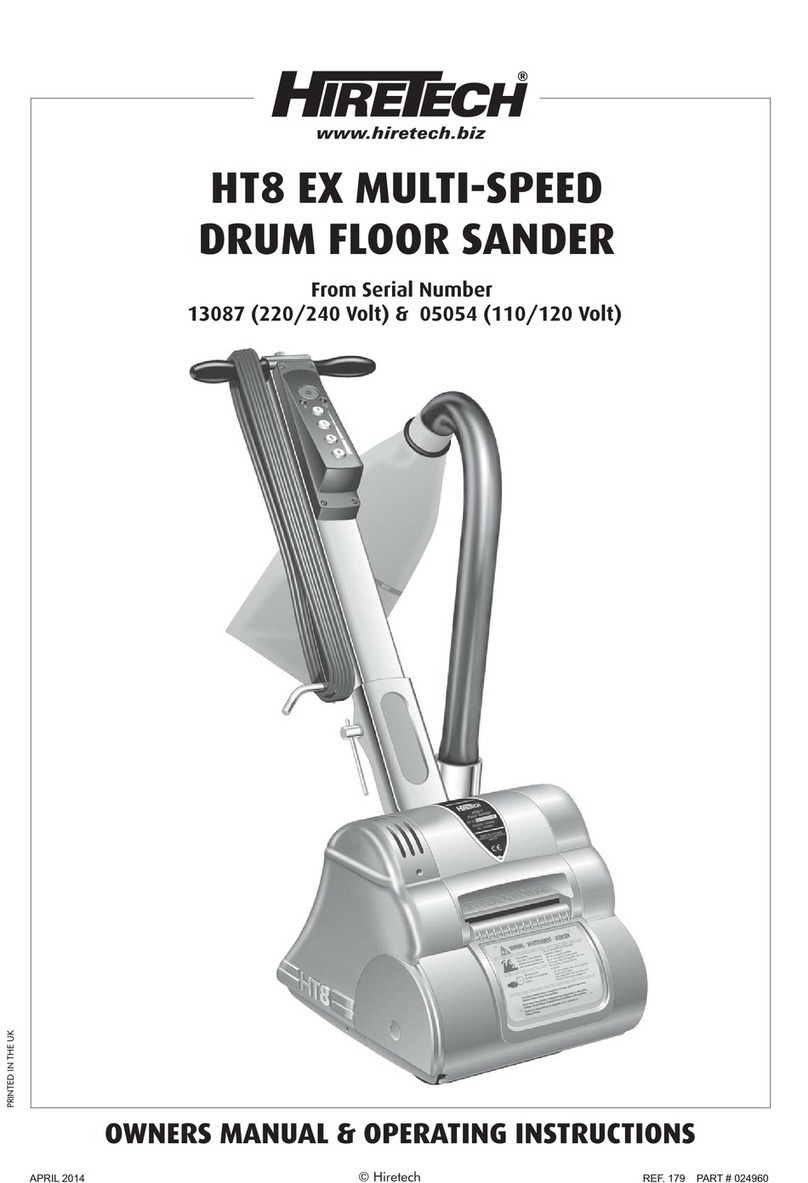
HireTech
HireTech HT8 EX User manual

HireTech
HireTech HT8 System manual
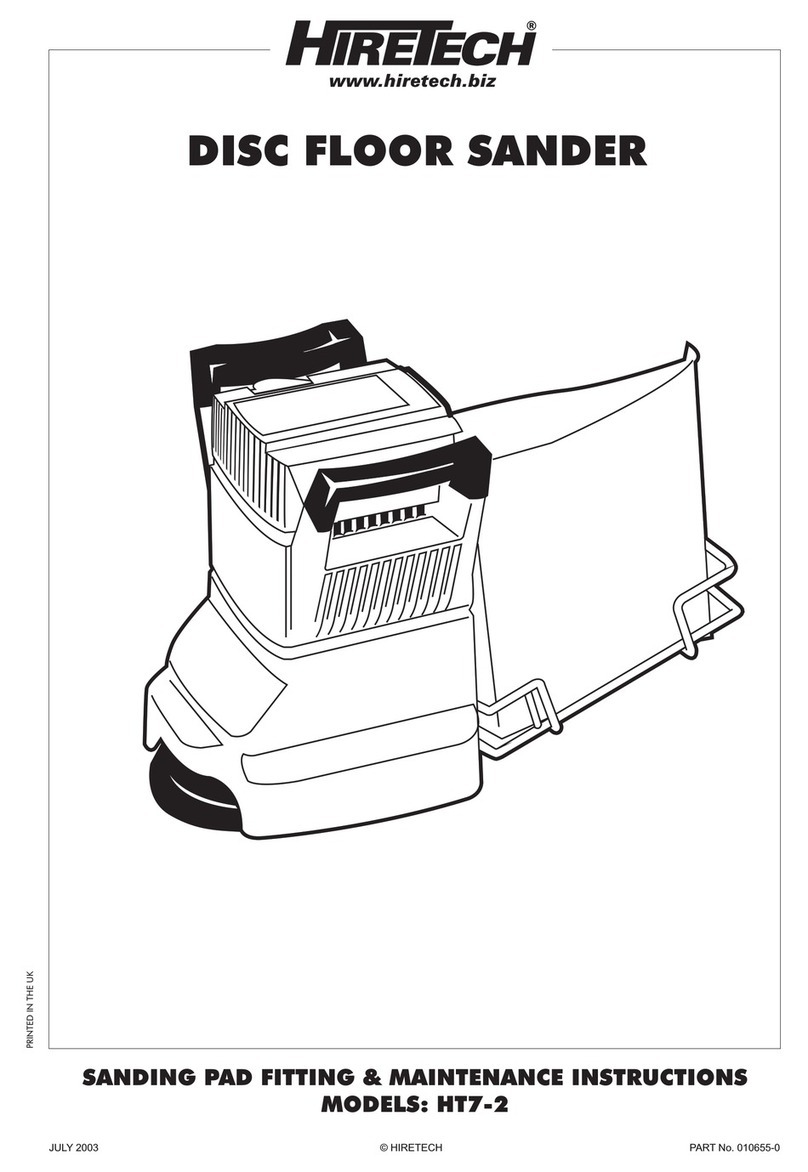
HireTech
HireTech HT7-2 User manual

HireTech
HireTech HT8-1.2 System manual
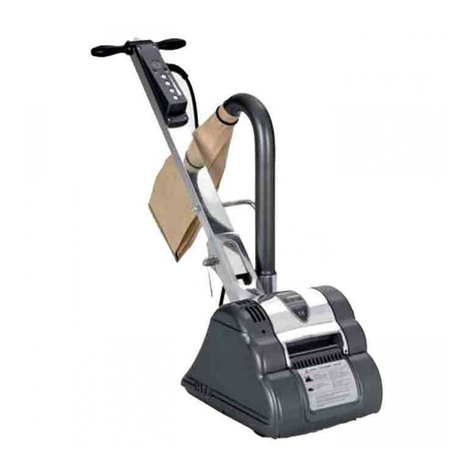
HireTech
HireTech HT8 System manual
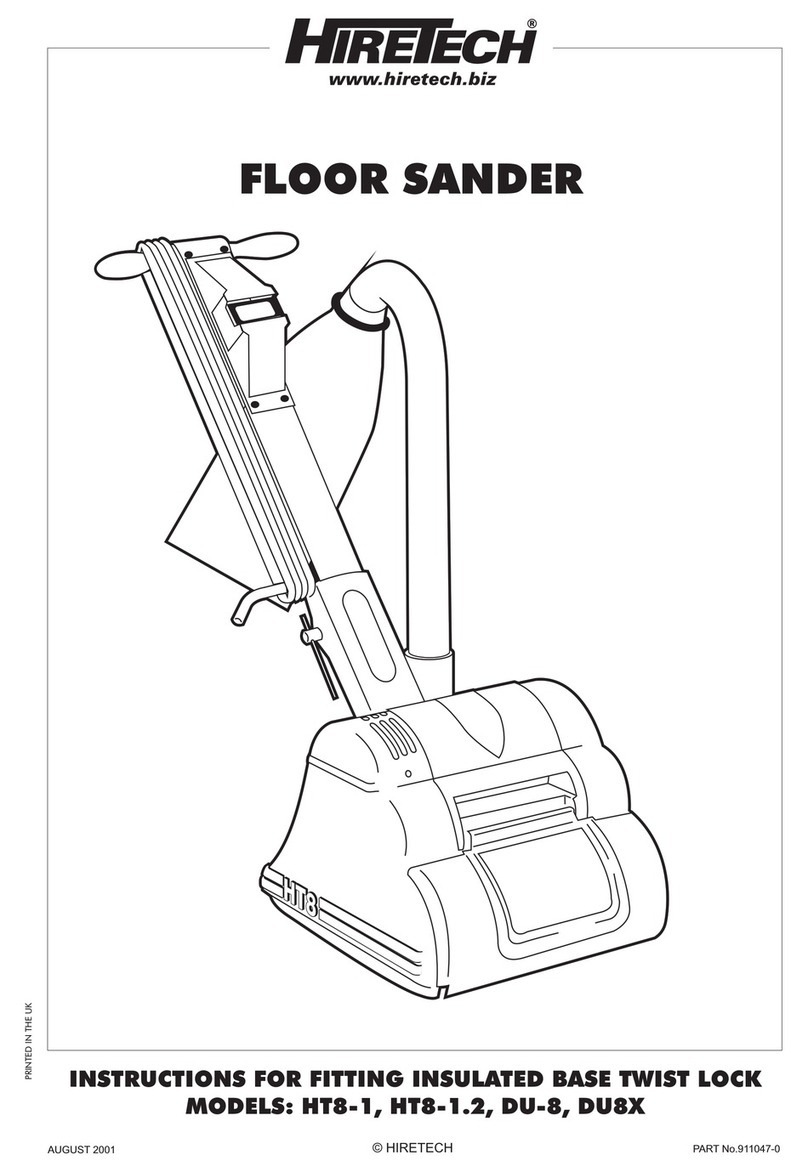
HireTech
HireTech HT8-1.2 User manual
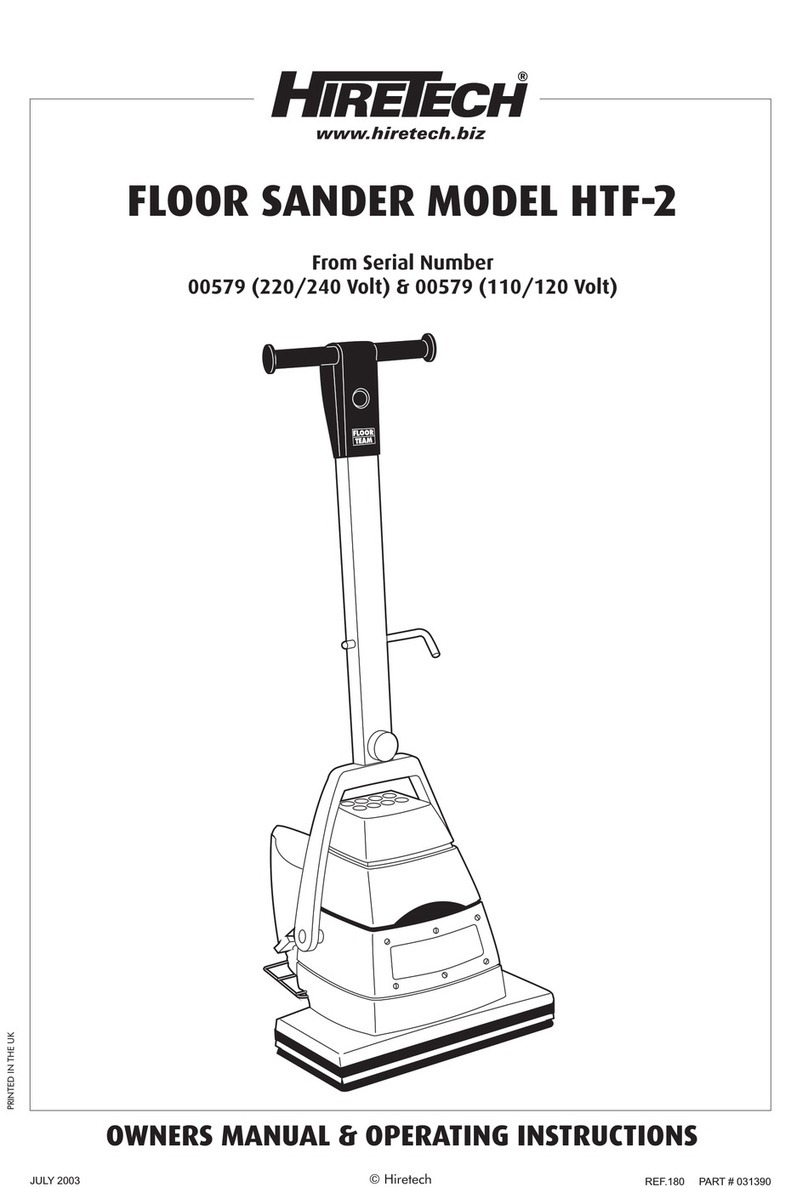
HireTech
HireTech HTF-2 System manual

HireTech
HireTech HT8 System manual
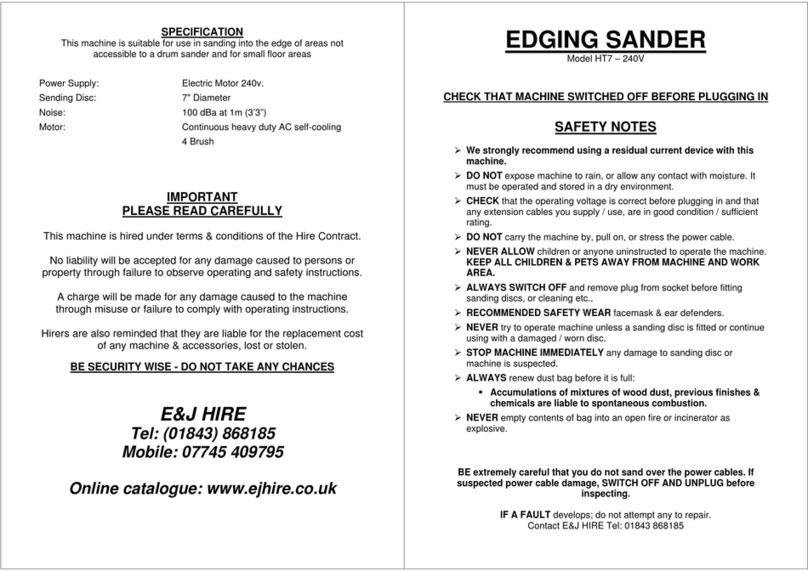
HireTech
HireTech HT7 User manual
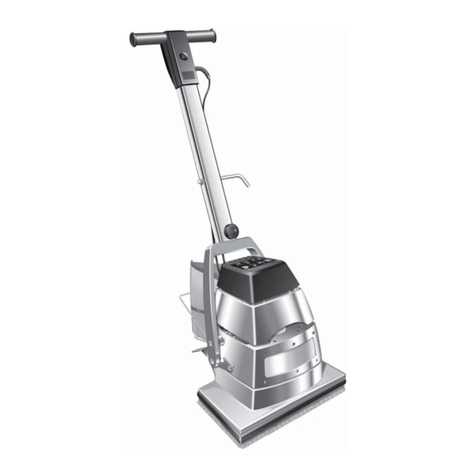
HireTech
HireTech HTF System manual
